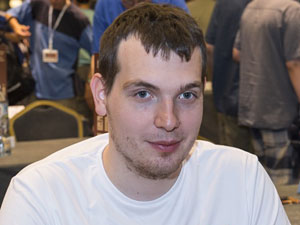40th World Chess Solving Championship
By John Nunn
|
 |

The 40th World Chess Solving Championship took place during the first week in August in Belgrade (above a night view from the Sava river), the capital of Serbia. In the past, Belgrade has hosted many famous chess events, such as part of the 1959 Candidates Tournament, the 1970 USSR-Rest of the World match and part of the Fischer-Spassky rematch in 1992. In recent years there hasn’t been so much chess activity in Serbia, but enthusiasm for the game remains high and there are signs of a revival. During my visit to Belgrade for the World Solving Championship I was interviewed on television and the event was covered in newspaper columns to an extent which would be impossible in most countries.

The centrally-located Metropol Palace Hotel provided very comfortable surroundings for the championship, which was efficiently organised by the Serbian Chess Problem Society. One innovation was the introduction of special events for juniors, both for composing and for solving. The average age of problemists tends to be higher than for over-the-board players and any effort to attract younger enthusiasts is welcome.
Another novel idea was a double-round rapidplay match over four boards between the solvers and a Serbian national team. This proved a real attraction and was a surprisingly high-level event. The teams were, for the solvers, Kacper Piorun, Aleksander Mista, Bojan Vuckovic and John Nunn (captain), and, for Serbia, Ivan Ivanisevic, Robert Markus, Milos Perunovic and Branko Damljanovic (captain Slavoljub Marjanovic). On rating the match was pretty even, although the highest-rated player was actually a solver (Kacper Piorun, currently 2681). A closely-fought match ended with a slightly unexpected victory for the solvers by 5-3. I won by 1.5-0.5 against Damljanovic, although admittedly I was lost at one point in both games. Unfortunately, I cannot find the games of this match anywhere otherwise I would give one (I don’t really want to show my own efforts).
In the main event, the Polish solving team of Aleksander Mista, Piotr Murdzia and Kacper Piorun was unchanged from the previous year and, with Piorun and Murdzia being two of the very best solvers in the world, they were clear favourites to win the title. The main battle in the team event was for second and third places and this turned out to be very close.
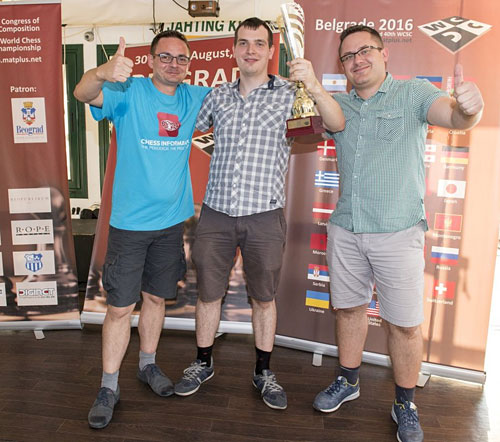
The Polish team of Piotr Murdzia, Kacper Piorun and Aeksander Mista
The format of the event has remained the same for many years, and consists of six solving sessions spread over two days. Each session is devoted to a different type of problem, and the event always kicks off with three mates in two. The chosen problems, this year selected by Brian Stephenson, proved somewhat easier than in recent years and, apart from a diabolical selfmate in six, on which all the competitors bar one scored zero points, there was nothing really hard. In solving, it is important to give complete solutions, mentioning all relevant variations, otherwise you lose marks and this year most of the points dropped by the leading solvers involved overlooking obscure variations.

Overview of the solving hall in Belgrade
I have selected some of the simpler problems for solving, so this is a good opportunity for those new to solving to have a go.
Here is one of the mates in two. If you would like to solve it under competition conditions, allow yourself seven minutes to find the solution (Solutions to all problems will be given in the second part of the article).
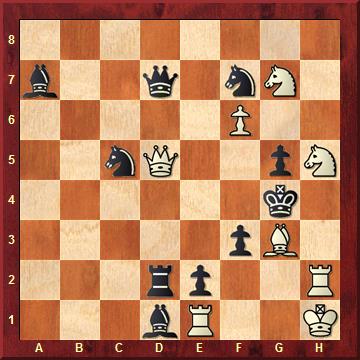
White to play and mate in two
As usual, the two-movers posed little difficulty for the solvers and the top 15 solvers all scored 100%. The three-movers proved slightly more troublesome, with a number of solvers missing one or two variations. Allow yourself 20 minutes for tournament conditions.

White to play and mate in three
The final round of the first day consisted of three studies and the study round is always difficult for those competitors who are primarily problemists. However, this time one of the studies also proved troublesome for some of the players, including myself, since there was a tempting try which could only be refuted by exceptionally precise play. Here is one of the easier studies; allow yourself 35 minutes to simulate tournament conditions.
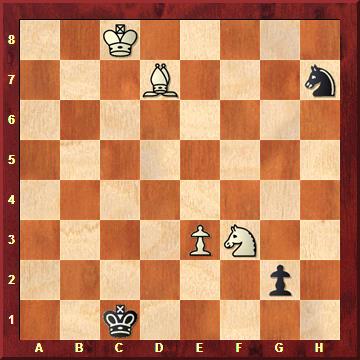
White to play and win
The first day ended with Poland in the lead, having made a perfect score of 90 out of 90. The British team had not had an especially good day and were in 7th place. In the individual results, the two top Polish solvers, Piorun and Murdzia, both had perfect scores of 45 out of 45, with Piorun being two minutes ahead on time, a factor which comes into play if there is a tie on points. No other solvers had a perfect score, and it was already apparent that the individual title would be a race between the Poles. My failure on the study round had left me in 10th place in the individual list.
The second day began with three helpmates, and unlike many recent solving events these proved to be fairly easy and many of the leading solvers, including the two Poles, scored 100%. However, Murdzia was very quick this round and solved all three problems in just 19 minutes (out of a maximum 50 minutes), leaving him 10 minutes ahead of Piorun on time.

Helpmate in three moves (three solutions)
In a helpmate, both sides are cooperating to help White mate Black (although the moves still have to be legal). Black moves first, with White mating Black on his third move, so the sequence of moves goes B W B W B W mates. There are three solutions to this problem.
The next round consisted of three moremovers (mates in more than three moves), and rather surprisingly many solvers overlooked a variation in a rather simple mate in 6, including the two leaders. However, crucially, Piorun was 11 minutes quicker than Murdzia and this left him one minute ahead on time. Here’s a mate in four which also proved quite tricky since it is easy to overlook a black defence.
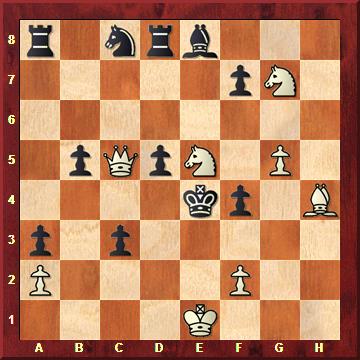
White to play and mate in four
The final round of selfmates often involves a degree of torture for the solvers. This time it was a next-to-impossible selfmate in six which caused the difficulty. As mentioned earlier, only one solver managed more than zero points on this problem; congratulations to Finnish solver Jorma Paavilainen on preventing a complete failure by the solvers. The other two selfmates weren’t difficult and most of the leading solvers scored 10 out of 15, although I made an unfortunate slip and dropped 0.8 points on the selfmate in three given below.

Selfmate in three moves
In a selfmate, White is trying to commit suicide by forcing Black to mate him. Black is doing his best to avoid mating White. White plays first, and must force Black to give mate on his third move.
Both Murdzia and Piorun scored ten points and took the full time, so the situation at the top remained unchanged, with the two having equal points but Piorun retaining his world title by the slimmest possible margin of one minute. Serbian solver Marjan Kovacevic, despite being heavily involved in the organisation of the event, did very well to finish third. I ended up in seventh place, perhaps a tiny bit disappointing but a reflection of the fact that there are a lot of good solvers around these days. The team event ended with Poland on 169 points (out of 180), well ahead of Lithuania 157, Serbia 156 and Great Britain 154. The British team were perhaps slightly unfortunate to finish just outside the medals, but there’s always next year!

The 2015 and 2016 World Solving Champion, Casper Piorun
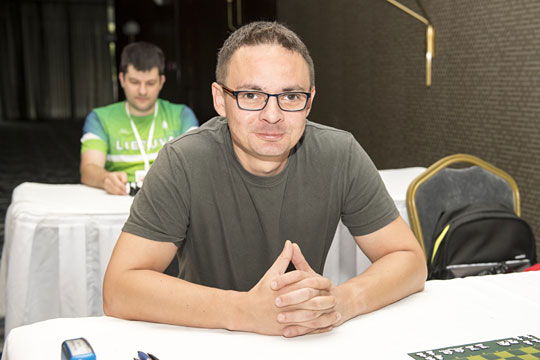
Runner-up Piotr Murdzia
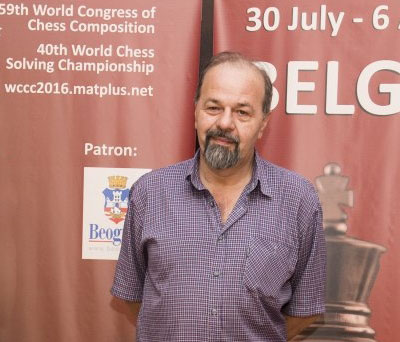
Third-placed Marjan Kovacevic, one of the main organisers, a leading solver and arguably the world’s best two-move problem composer
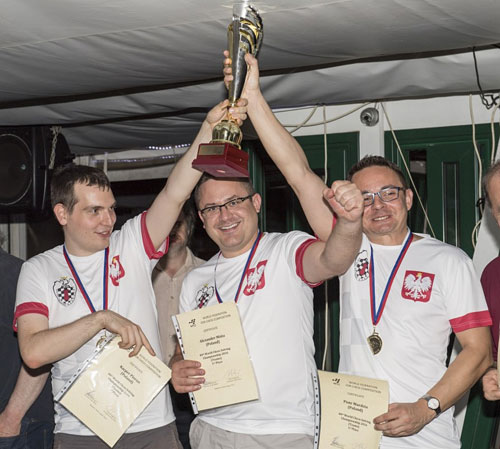
The Polish team celebrates an outstanding success
I won the senior (60 years or over) prize with 77.2 points and the junior prize (23 years or under) went to Zaur Mammedov of Azerbaijan with 75.9 points. The young Azerbaijan team has already made an impact in the solving world and will doubtless have many successes in the future.
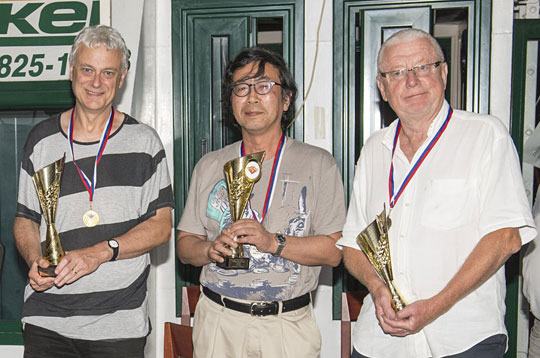
The Senior medal winners, John Nunn, Tadashi Wakashima and Alain Villeneuve. The full results and all the problems and solutions can be downloaded from this page.
The Serbian problemists deserve congratulations for organising a splendid event and I am sure everyone is looking forward to Dresden in 2017. Finally, I would like to thank global investment managers Winton for sponsoring the British team. Without their support it wouldn’t have been possible to field our top solvers in Belgrade.
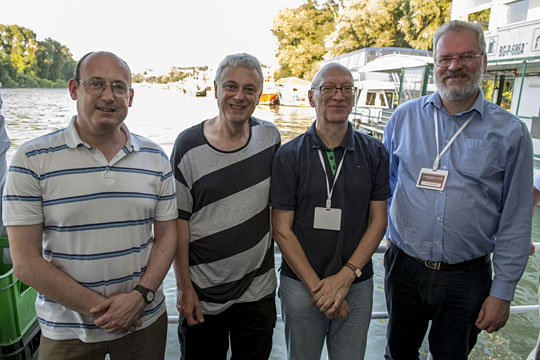
The British solving team, Michael McDowell, John Nunn, Jonathan Mestel and Colin McNab going for a trip along the Danube
All photographs copyright Franziska Iseli
